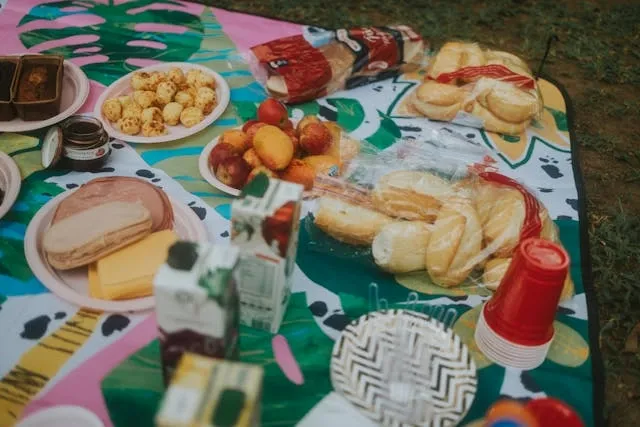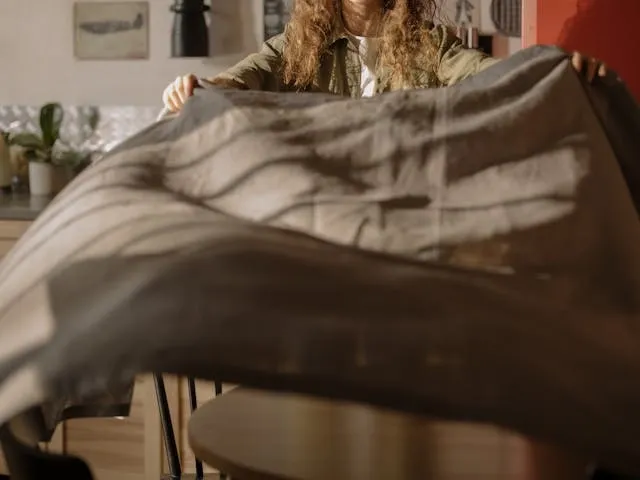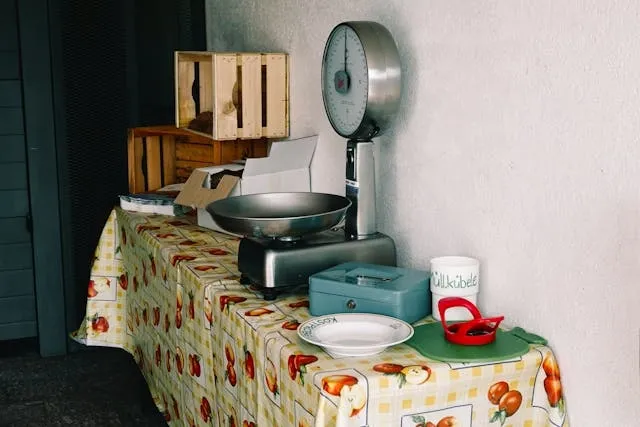How To Clean Plastic Table Cover? Stain Removing Tips, Restore Shine And Quick Ways
Plastic and vinyl table covers have become a staple in homes, restaurants, and event venues because of their durability, waterproof protection, and ease of maintenance. However, even the toughest materials require proper care to maintain clarity and shine over time.
In this guide, we provide expert-verified steps and professional recommendations for how to wash plastic table covers, remove stains naturally, and store them to prolong their lifespan.
Follow these strategies to maintain elegance and longevity.

Key Takeaways
- Always use mild soap and lukewarm water when cleaning any vinyl or plastic tablecloth, and avoid heat, bleach, and ammonia-based products.
- For deeper cleaning, alternate between hand-washing and gentle machine cycles, and consider vinegar or baking soda for safe, natural stain removers.
- Proper air drying and flat storage prevent cracking and creasing, and remember that consistent light cleaning is better than infrequent heavy scrubbing.
- We supply high-quality custom table covers that are machine-washable and durable for a range of applications.
Table of contents
-
How To Clean Plastic Table Cover?
-
Cleaning Tips For Heavy Duty Vinyl Table Covers
-
How To Clean Plastic Table Covers In A Washing Machine?
-
How To Hand-Wash Vinyl Tablecloths?
-
How To Clean Plastic Table Cover With Vinegar For A Natural Shine
-
How To Remove Stains And Stubborn Marks From Plastic Table Covers
-
How To Clean Clear Plastic Table Covers Without Streaks
-
How To Care For And Store Vinyl Tablecloths After Cleaning
-
How To Remove Static From Plastic Table Covers
How To Clean Plastic Table Cover?
The most effective method for how to clean plastic table covers starts with simplicity. You need to wipe the surface using a soft sponge or microfiber cloth soaked in warm water mixed with mild dish soap.
Here are some tips for best results:
- Gently scrub in circular motions to lift dirt, food residues, and oils.
- Avoid scouring pads, as these can scratch and dull the surface.
- After cleaning, rinse with a damp cloth to remove any soap residue, as this can leave streaks.
- Always air dry flat - never use a dryer or expose vinyl to direct sunlight for long periods, as heat may cause shrinkage or brittleness.
- For stubborn areas, apply a diluted vinegar solution and rinse thoroughly.
Consistent, gentle care preserves both flexibility and gloss to keep your plastic table cover looking new and professional. Remember that cleaning methods will vary for different materials like custom spandex table covers.

Cleaning Tips For Heavy Duty Vinyl Table Covers
Heavy-duty vinyl tablecloths used for banquets, patios, or restaurants can accumulate grime more quickly. When learning how to clean a vinyl tablecloth, the key is to use mild dish soap in warm water - never hot - and a soft sponge.
Apply light pressure in repetitive strokes rather than harsh scrubbing. It is also important to avoid strong chemicals that might weaken protective coatings and cause discoloration - steer clear of things like:
- Bleach
- Ammonia
Historical research shows that tablecloths are seen as symbols of refinement, so keeping them looking pristine is important. If there is thick grease buildup, add a teaspoon of baking soda to your cleaning solution to boost effectiveness without abrasion.
After washing, rinse with clean water and hang to dry in the shade. Daily maintenance makes things easier - use custom cork coasters to prevent spills and wipe with a damp cloth after each meal to prevent buildup and reduce the need for deep cleaning.
These habits extend the lifespan of your heavy-duty vinyl covers while keeping them sanitary, shiny, and pleasant to use for years.
How To Clean PVC And Vinyl Tablecloths
PVC and vinyl may look similar, but they react differently to cleaning methods. For routine care, both materials can be wiped with a soft cloth dipped in mild soapy water. However, if you’re exploring how to clean PVC tablecloths versus vinyl, note that PVC tolerates slightly stronger cleaning agents.
For deep cleaning, you can soak either fabric in warm - not hot - water for five to ten minutes before wiping down with a cloth and rinsing thoroughly. Air drying is important to prevent creases and avoid heat exposure that could warp the surface. This process will remove things like:
- Oils
- Residues
Use a microfiber towel for final polishing to restore the clear shine that is often lost after multiple washes. Proper differentiation ensures your vinyl or PVC table covers maintain their smooth texture and protective quality. And there are different methods again for how to wash a polyester tablecloth.
Looking for an alternative to plastic table covers?
Work with us to create custom stretch table covers with logos for the ultimate low-maintenance, fitted solution.
How To Clean Plastic Table Covers In A Washing Machine?
Although hand-washing is safest, some durable plastic or vinyl covers can withstand a gentle machine cycle. To wash plastic tablecloths in a washing machine, the first step is to fold the cloth loosely, place it in the drum without other fabrics, and add a small amount of mild detergent.
From here, do the following:
- Set the washer to a cold or gentle cycle - never warm or hot.
- Avoid using any kind of bleach or fabric softener.
- Once the wash cycle is complete, remove immediately and hang to air dry.
- Avoid wringing or tumble-drying, which may cause cracks.
This method works best for soft-backed vinyl or flannel-lined covers that resist creasing. As a practical option, you could work with us to create machine-wash-friendly custom cheap polyester tablecloths in bulk. Our products allow deep customization to combine beauty, resilience, and convenience.
How To Hand-Wash Vinyl Tablecloths?
For delicate or decorative vinyls, hand-washing is the preferred cleaning method. Start by rinsing the tablecloth under lukewarm water to remove loose debris. From here:
- Mix mild dish soap in a bucket, dip a soft cloth or sponge, and gently wipe both sides of the fabric.
- Pay extra attention to edges where grime tends to collect.
- After cleaning, rinse with cool water until no soap remains.
- Hang or lay the tablecloth flat to air dry naturally - never fold when damp as it could cause mildew.
- Finish by buffing the surface lightly with a microfiber towel to restore shine.
Understanding how to wash a vinyl tablecloth by hand ensures preservation of elasticity and finish to maintain your table’s elegance. It can be helpful to act quickly, so always have some premium beverage napkins to hand to wipe up spills before they set in.
How Often Should You Wash Vinyl Tablecloths?
The frequency of washing depends on usage and environment. For dining tables used daily, wipe your vinyl or plastic tablecloth after every meal and deep-clean weekly. For occasional use, like outdoor or event covers, clean before storage and again before reuse.
Frequent light cleaning is more effective than aggressive scrubbing after buildup occurs. Research on restaurants suggests that cleaning with contaminated cloths can increase bacterial counts, so your choice of cleaning implement is important. Regular maintenance also help avoid:
- Permanent stains
- Mildew growth
If your tablecloth protects wooden furniture, make sure it’s completely dry before placing it back to prevent trapped moisture. Establishing a routine helps your vinyl last longer and retain its glossy appearance.
In short, knowing how often to wash vinyl tablecloths ensures hygiene, aesthetics, and longevity without unnecessary wear or fading.
Create your own durable, easy-clean tablecloths
With our service, you can create custom polyester tablecloths that are easy to maintain for repeated use.
Learn moreHow To Clean Plastic Table Cover With Vinegar For A Natural Shine
Vinegar is an eco-friendly cleaning powerhouse ideal for how to clean plastic table covers safely. Mix equal parts white vinegar and water in a spray bottle, apply lightly to the surface, and wipe with a soft microfiber cloth.
The benefits of white vinegar are that it:
- Cuts grease
- Disinfects
- Neutralizes odors
For clear vinyl, rinse afterward to prevent cloudiness. Avoid over-soaking as excess moisture can dull plastic finishes. For extra shine, buff dry with a lint-free towel. And be mindful of how to get wrinkles out of polyester tablecloths and other materials if this becomes an issue.
This natural cleaner restores brightness without chemicals and is safe for households with children or pets. Using vinegar regularly helps prevent residue buildup from soaps or oils. WHen you use vinegar regularly, you prevent residue buildup from soaps or oils, giving your vinyl or PVC tablecloths a clean, fresh appearance.
How To Make And Use Baking Soda Paste For Stains?
When facing stubborn stains, baking soda is a gentle yet powerful ally. To use it, combine baking soda with a small amount of water to form a paste. Apply it directly to stained areas of your plastic tablecloth, allowing it to sit for 15-30 minutes.
From here, rub it gently with a soft cloth or sponge before rinsing thoroughly. This paste will not damage the vinyl’s surface, but it is effective at lifting:
- Dyes
- Food stains
- Grime
For oil-based marks, repeat the process twice for best results. Baking soda is a safe, non-abrasive, and budget-friendly cleaning option. Research highlights that tablecloths are both functional and aesthetic, so it is crucial to keep plastic and vinyl covers spotless.
This solution is perfect for anyone looking for eco-conscious cleaning options.

How To Remove Stains And Stubborn Marks From Plastic Table Covers
Stain removal depends on identifying the source. When learning how to clean plastic tablecloth covers effectively, remember that gentle persistence works better than harsh scrubbing.
Here are some tips for different types of stains:
- Food and beverage marks: A mixture of dish soap and warm water is usually enough.
- Ink: Use a dab of rubbing alcohol on a cotton pad - test first on a hidden area. Avoid acetone as it can melt or dull vinyl.
- Oil: These stains respond best to the baking soda paste method.
- Discoloration: Whether from heat or dyes, the solution may be diluted vinegar.
Always rinse thoroughly to avoid soap buildup, as this can attract dust. Conservation research on heritage tablecloths shows that stains and aging lead to deterioration in appearance, so proactive cleaning can help ensure they last longer.
Treating stains promptly maintains your table’s polished look and prevents damage to the protective coating that gives vinyl its signature sheen.
|
Type of Stain |
Recommended Cleaning Method |
Extra Notes / Cautions |
|
Food & Beverage Marks |
Mix a few drops of dish soap with warm water and wipe gently using a soft cloth. |
Usually sufficient for everyday spills — rinse and dry afterwards to prevent residue. |
|
Ink |
Dab with rubbing alcohol on a cotton pad or cloth. Always test first on a hidden area. |
Avoid acetone — it can melt, cloud, or dull vinyl surfaces. |
|
Oil & Grease |
Apply a baking soda paste (3 parts baking soda to 1 part water). Let sit briefly, then wipe clean. |
Effective for greasy residues from sauces or fingerprints. |
|
Discoloration (Heat or Dyes) |
Wipe with diluted white vinegar (1 part vinegar to 1 part water). |
Helps lift colour transfer and mild heat staining. Always rinse and dry fully afterwards. |
Need tablecloths for an outdoor occasion?
Our custom outdoor table covers are built to withstand the elements and you can easily clean and maintain them.
How To Clean Clear Plastic Table Covers Without Streaks
For transparent covers, clarity is everything. To clean without streaks, use a solution of one part vinegar and two parts water, wiping gently with a soft microfiber cloth. Studies have found that the color and cleanliness of a tablecloth influence diners’ emotions and appetite, so careful cleaning is important.
Avoid paper towels, as they can leave things like:
- Lint
- Tiny scratches
Rinse with cool water and buff dry using a clean, dry cloth. Never use wax or glass cleaner containing ammonia. When learning how to clean a clear vinyl tablecloth, remember that excess moisture often causes streaks, so wring out your tablecloth before wiping.
With this approach, you can restore a glass-like finish, keeping your clear table covers visually appealing and ready for display. With routine care, transparency lasts longer, enhancing your table’s natural beauty.
How To Care For And Store Vinyl Tablecloths After Cleaning
Proper post-cleaning care determines how long your tablecloth stays in prime condition. After washing, make sure it is completely dry before folding. If possible, roll instead of fold to prevent creases that may lead to cracking.
Here are some storage tips:
- Always store in a cool, dry space away from direct sunlight or heat sources.
- Avoid storing near heavy objects that could press sharp edges into the vinyl.
- When you next need the cover, unroll it flat at room temperature before use.
By following these practices on the best washable tablecloths for wood, your vinyl or PVC tablecloth will maintain flexibility and shine for years. Long-term care is just as important as cleaning - consistent attention preserves value and presentation quality.

Create a table cover for any occasion
Our custom print-on-demand tablecloths are the perfect way to elevate your decor with a practical, easy-to-clean solution.
Get startedHow To Remove Static From Plastic Table Covers
Static electricity tends to build on plastic in dry indoor environments. To eliminate it, lightly mist the surface with diluted vinegar or use an anti-static spray designed for vinyl. Another natural option is to wipe with a fabric softener sheet which neutralizes static quickly.
Here are a couple of other tips:
- Maintaining humidity in the room can help to reduce static buildup.
- For outdoor use, grounding the tablecloth edges with clips or weights can minimize friction between surfaces.
Knowing how to clean and maintain plastic table covers beyond surface cleaning improves comfort and usability. If you are a frequent entertainer or event planner handling these materials daily, take the right steps and precautions to preserve your custom printed tablecloths.
Frequently Asked Questions About How To Clean Plastic Table Cover
How To Clean Plastic Table Cover The Right Way?
The correct way is to wipe with a mild soap solution, rinse thoroughly, and air dry. Avoid abrasive tools or heat, and consider vinegar or baking soda for deeper cleaning.
How To Clean Plastic Table Cover With Vinegar For Shine?
Mix one part vinegar with one part water, spray lightly, wipe with a microfiber cloth, and buff dry. This natural cleaner removes grease and restores shine without harsh chemicals.